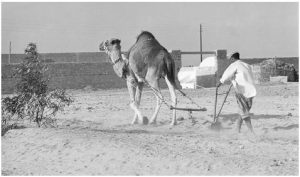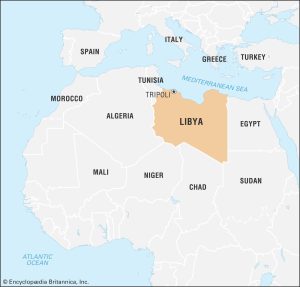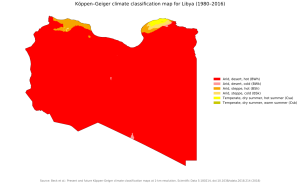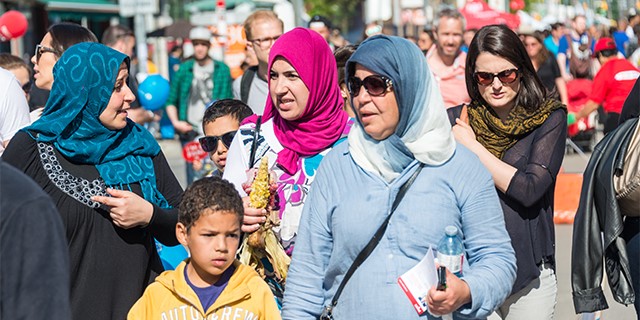History of Libya
Libya, officially known as the State of Libya, is a country located in North Africa. Its history spans over several thousand years, with the earliest evidence of human habitation dating back to 8000 BCE. Throughout its history, Libya has been a center of trade, commerce, and cultural exchange due to its strategic location on the Mediterranean coast.
Ancient Libya was inhabited by Berber tribes, who traded with other civilizations such as the Phoenicians, Greeks, and Romans. The city of Cyrene, founded by the Greeks in the 7th century BCE, became a major center of learning and culture in the Mediterranean world.
In 643 CE, Libya was conquered by the Arab armies of Islam, and the region became part of the Umayyad Caliphate. The country was ruled by a series of Arab and Berber dynasties until the 16th century, when it came under Ottoman rule.
During the 20th century, Libya was colonized by Italy, which ruled the country from 1911 until 1943. After World War II, Libya became an independent country in 1951, with King Idris as its leader. However, in 1969, a group of military officers led by Colonel Muammar Gaddafi seized power in a coup and established a socialist government.
Gaddafi’s regime was characterized by authoritarianism, repression, and human rights abuses. In the 1980s, Libya became involved in several international conflicts, including supporting terrorist groups, which led to UN sanctions and a US-led bombing campaign in 1986.
In 2011, during the Arab Spring, a popular uprising against Gaddafi’s regime broke out, leading to a civil war. The rebels were supported by a coalition of NATO forces, which bombed Libyan military targets and enforced a no-fly zone. Gaddafi was captured and killed in October 2011, and the National Transitional Council (NTC) was established as an interim government.
However, the NTC struggled to establish control over the country, and Libya has since been wracked by violence and instability. The country is currently divided between two rival governments, with the internationally recognized Government of National Accord (GNA) based in Tripoli, and the Libyan National Army (LNA) based in Tobruk.
In conclusion, Libya’s long history has been marked by trade, cultural exchange, colonization, and political turmoil. The country’s current situation remains uncertain, with ongoing conflict and instability.

Location
Libya is a country located in North Africa, bordering the Mediterranean Sea to the north. It is located between 19° and 34° north latitude and 9° and 25° east longitude. (Central Intelligence Agency, n.d.). Libya is bordered by Tunisia and Algeria to the west, Niger and Chad to the south, Sudan to the southeast, and Egypt to the east. (Central Intelligence Agency, n.d.)
According to the United Nations, Libya has a total land area of 1,759,540 square kilometers. (United Nations, n.d.)The capital city of Libya is Tripoli, which is located on the country’s northwestern coast. Other major cities in Libya include Benghazi, Misrata, and Tobruk. (Central Intelligence Agency, n.d.)
In summary, Libya is located in North Africa, bordered by the Mediterranean Sea to the north, and is bordered by Tunisia, Algeria, Niger, Chad, Sudan, and Egypt. The country’s capital city is Tripoli. (Central Intelligence Agency, n.d.; United Nations, n.d.)

Climate
Libya, located in North Africa, is the fourth largest country in Africa and has a diverse climate due to its topography and location. The country experiences a hot desert climate, which is characterized by high temperatures, low rainfall, and frequent sandstorms (Klein, 2019).
The Climate Regions of Libya
Libya can be divided into two main climate regions, the coastal zone and the inland zone. The coastal zone, which is around 100 km wide, has a Mediterranean climate with mild winters and warm summers. In contrast, the inland zone has a desert climate, which covers about 90% of the country. This region is characterized by high temperatures and low rainfall (Munawar, 2020).
Temperature
The temperature in Libya is generally high throughout the year, with an average temperature of around 30°C. During the summer months, which extend from June to September, temperatures can reach up to 45°C. In contrast, during the winter months, which extend from December to February, temperatures can range from 12 to 20°C (United Nations Development Programme [UNDP], 2020).
Rainfall
Libya is a very arid country with low rainfall throughout the year. The coastal region receives around 200-400 mm of rainfall annually, while the inland region receives less than 100 mm (Munawar, 2020). The majority of the rainfall occurs during the winter months, with some areas experiencing occasional thunderstorms.
Winds
Libya is known for its strong winds, which are caused by its location in the Saharan Desert. The most prominent wind is the sirocco, which blows from the south and can bring hot and dry conditions. The sirocco is also known to cause sandstorms, which can be very severe and impact transportation and agriculture (Klein, 2019).
Impacts of Climate Change
Climate change is having a significant impact on Libya, with rising temperatures and changes in rainfall patterns. The country is experiencing more frequent heatwaves and droughts, which are causing water shortages and damaging crops. The coastal region is also experiencing coastal erosion and an increase in sea levels, which is impacting infrastructure and agriculture (UNDP, 2020).
In conclusion, Libya has a hot desert climate with low rainfall and high temperatures. The country can be divided into two main climate regions, the coastal zone, which has a Mediterranean climate, and the inland zone, which has a desert climate. Libya is also known for its strong winds, which can cause sandstorms. Climate change is having a significant impact on the country, with rising temperatures, changes in rainfall patterns, and an increase in sea levels, which is impacting infrastructure and agriculture.

Languages
Libya, officially known as the State of Libya, is a North African country that has a rich linguistic diversity. The country has a population of about 7 million people, with the majority being Arabic speakers. However, there are several other languages spoken in the country.
Arabic is the official language of Libya and is spoken by most of the population. The Arabic spoken in Libya is a variant of the North African Arabic dialect, which is distinct from the Arabic spoken in the Middle East (Abdalla, 2015). The Libyan Arabic dialect is characterized by several unique features, including the use of loanwords from Berber and Italian, as well as the use of some words that are not used in other Arab countries (Abdalla, 2015). Libyan Arabic is also known for its musicality and poetic qualities, and it has a strong influence on the country’s literature and culture.
In addition to Arabic, there are several other languages spoken in Libya, including Berber, which is spoken by a significant minority of the population. Berber is a group of closely related languages that are spoken in North Africa, and it has been present in Libya for thousands of years (Maddy-Weitzman, 2016). The Berber languages in Libya include Tamazight, Tamasheq, and Ghadames, among others. The Berber languages are primarily spoken in the western and southern regions of the country and are recognized as official languages in those areas.
There are also several immigrant languages spoken in Libya, including Italian, English, and French. Italian was once the official language of Libya during the colonial period, and it is still spoken by some of the older generation, especially in the cities (Abdalla, 2015). English and French are also spoken by some Libyans, particularly those who have received education or have worked in multinational companies or diplomatic missions.
The linguistic diversity of Libya is significant, as it reflects the country’s rich history and cultural heritage. The country’s diverse linguistic landscape also reflects its colonial past and its role as a crossroads between Europe, Africa, and the Middle East (Maddy-Weitzman, 2016). Despite the diversity of languages spoken in Libya, Arabic remains the dominant language, and it is used in government, education, and the media.
In conclusion, Libya is a linguistically diverse country with several languages spoken by different groups of people. The country’s official language is Arabic, which is spoken by most of the population. Berber is also a significant language in Libya, spoken by a minority in the western and southern regions. The linguistic diversity of Libya reflects its rich history and cultural heritage, and it underscores the country’s role as a crossroads between Europe, Africa, and the Middle East.



